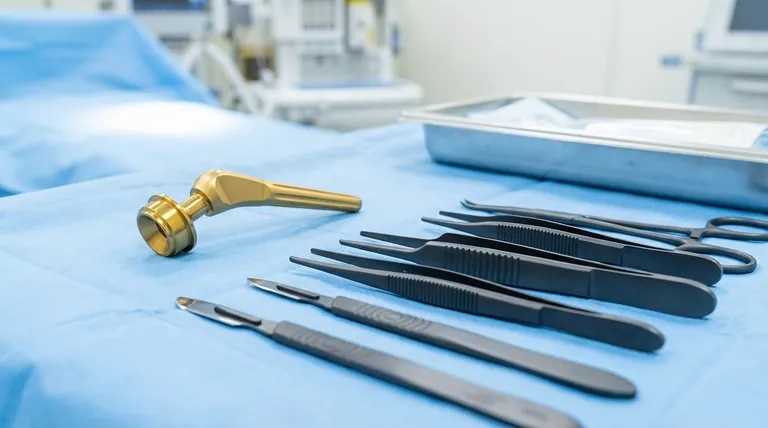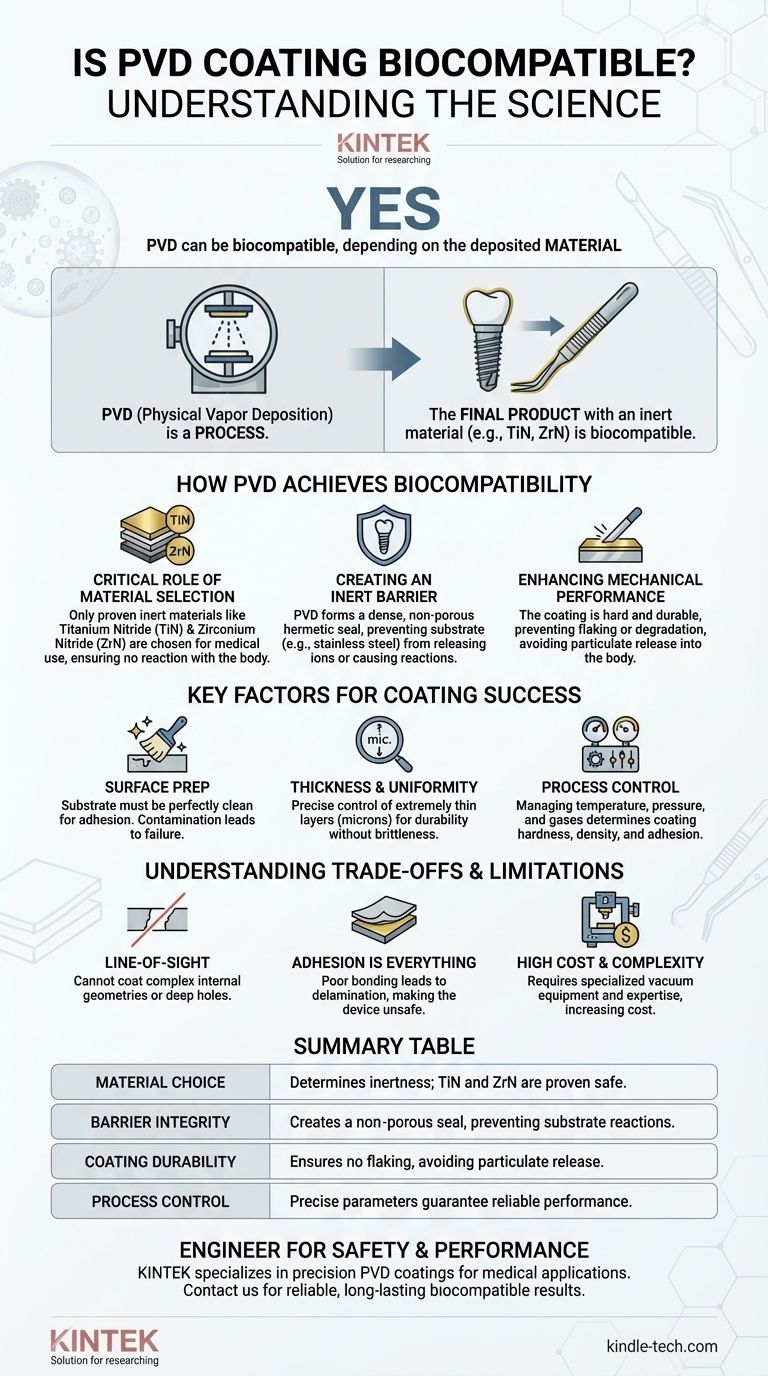Yes, many PVD coatings are biocompatible, but this property is not inherent to the process itself. Biocompatibility is entirely determined by the specific material being deposited onto the surface. When materials known for their inertness and safety within the human body—such as Titanium Nitride (TiN)—are applied using the PVD process, the resulting coated product is considered biocompatible.
The key is to understand that Physical Vapor Deposition (PVD) is a method of application, not a substance. The process allows you to bond an extremely thin, durable, and biocompatible material onto a substrate, creating a final product that is safe for medical use.

How PVD Achieves Biocompatibility
The effectiveness of PVD for medical applications comes from its ability to fundamentally alter the surface properties of a component, creating a stable and safe interface for contact with the human body.
The Critical Role of Material Selection
The single most important factor is the choice of coating material. PVD can deposit a wide range of materials, but for medical devices, specific ones are chosen for their proven history of inertness.
Common biocompatible PVD materials include Titanium Nitride (TiN) and Zirconium Nitride (ZrN). These materials do not react with bodily fluids or tissues, preventing adverse reactions.
Creating an Inert Barrier
Many medical implants and surgical tools are made from substrates like stainless steel. While strong, these materials can sometimes release ions (like nickel) that may cause allergic reactions or other issues.
PVD applies a dense, non-porous coating that acts as a hermetic seal. This barrier prevents the underlying substrate material from coming into direct contact with the body, ensuring the device is safe. The high corrosion resistance of the PVD layer is fundamental to this function.
Enhancing Mechanical Performance
Biocompatibility isn't just about chemical inertness; it's also about physical stability. A coating that wears down, flakes off, or degrades can release particulate debris into the body, which is not safe.
PVD coatings are exceptionally hard and durable. By increasing the surface hardness and wear resistance of an implant or tool, PVD ensures the device maintains its integrity for its entire functional life, a critical factor for long-term implants.
Key Factors Influencing Coating Success
Achieving a reliable biocompatible coating requires precise control over the entire process. The quality of the final surface depends on more than just the material.
Substrate and Surface Preparation
The PVD coating is only as good as its bond to the substrate. The surface of the component must be perfectly clean and properly prepared before entering the vacuum chamber. Any contamination will compromise adhesion, potentially leading to coating failure.
Coating Thickness and Uniformity
PVD coatings are extremely thin, typically measured in microns. The thickness must be carefully controlled to provide sufficient durability without becoming brittle. Achieving a uniform coat across the entire surface is essential for consistent performance.
Process Control
The properties of the final coating—such as hardness, density, and adhesion—are controlled by carefully managing variables within the PVD vacuum chamber. Factors like temperature, pressure, and the composition of reagent gases must be precisely managed to produce the desired biocompatible layer.
Understanding the Trade-offs and Limitations
While powerful, the PVD process has inherent characteristics that must be considered during the design phase of any medical component.
It's a Line-of-Sight Process
PVD works by bombarding a surface with coating material in a straight line. This means the process cannot easily coat complex internal geometries, undercuts, or the inside of small, deep holes. Parts must be fixtured carefully to ensure all critical surfaces are exposed.
Adhesion is Everything
The entire benefit of the coating hinges on its ability to stay bonded to the substrate. Poor surface preparation or improper process parameters can lead to delamination, rendering the device useless and potentially unsafe.
High Cost and Complexity
The PVD process requires a high-purity vacuum environment and specialized equipment. This makes it a more expensive and complex operation than simpler finishing methods, requiring significant technical expertise to perform correctly.
Making the Right Choice for Your Goal
PVD coating is a powerful tool for engineering medical devices, provided the application aligns with the process's capabilities.
- If your primary focus is patient safety: Use PVD to apply a proven inert material like TiN or ZrN, creating a robust barrier over substrates that may contain potential allergens like nickel.
- If your primary focus is implant longevity: Leverage PVD to deposit a hard, low-friction coating that dramatically increases wear resistance and prevents material degradation over time.
- If your primary focus is surgical instrument performance: Apply a non-reflective PVD coating to reduce glare under operating lights or a TiN coating to maintain a hard, sharp edge on cutting tools.
When engineered correctly, PVD is one of the most effective methods for creating safe, durable, and high-performance surfaces for medical applications.
Summary Table:
| Key Factor | Why It Matters for Biocompatibility |
|---|---|
| Material Choice | Determines inertness; TiN and ZrN are proven safe for body contact. |
| Barrier Integrity | Creates a non-porous seal to prevent substrate reactions with bodily fluids. |
| Coating Durability | Ensures no flaking or degradation, avoiding particulate release in the body. |
| Process Control | Precise parameters guarantee consistent, reliable coating performance. |
Ensure your medical devices meet the highest standards of safety and performance. KINTEK specializes in precision PVD coatings for laboratory and medical equipment, using biocompatible materials like Titanium Nitride (TiN) to enhance durability and patient safety. Let our expertise in surface engineering help you achieve reliable, long-lasting results for implants, surgical tools, and more. Contact us today to discuss your specific coating needs!
Visual Guide

Related Products
- Custom CVD Diamond Coating for Lab Applications
- RF PECVD System Radio Frequency Plasma-Enhanced Chemical Vapor Deposition RF PECVD
- Vacuum Hot Press Furnace Machine for Lamination and Heating
- High-Purity Titanium Foil and Sheet for Industrial Applications
- Molybdenum Disilicide (MoSi2) Thermal Elements Electric Furnace Heating Element
People Also Ask
- What are the three types of coating? A Guide to Architectural, Industrial, and Special Purpose
- How are tools coated with diamond? Achieve Superior Hardness and Low Friction for Your Tools
- What are diamond coated films? Enhance Materials with Super-Hard, Transparent Layers
- What is the process of CVD diamond coating? Grow a Superior, Chemically-Bonded Diamond Layer
- What is diamond coating film? A Thin Layer of Diamond for Extreme Performance



















